Introduction
The textile industry in India has been one of the major supportive industries, has maintained its constant growth for many years, and has succeeded in giving a modern touch to tradition. Being as old as civilisation itself, the Indian textile industry is not only one of the most prosperous segments of the Indian economy, but it also reflects the hundreds of thousands of years of history of the country. Today it is among the leading exporters of textiles and garments with an extremely diverse choice of fibres, patterns, and processing methods.
Why should this interest you? The textile and apparel industries of India have recorded phenomenal growth of the textile industry in India in the last 10 years. From adopting the most up-to-date available technologies to practising sustainability, the sector is going through a massive transformation. This advancement equally fosters economic development and shapes the world fashion industry, thereby creating opportunities for existing and prospective businesspersons, crafters, and users. Additionally, the future of the textile industry in India remains bright; indeed, the industry is heading towards more advanced areas such as smart textiles, sustainable production, and the concept of the circular economy.
Here, I will dig out the possibilities of the textile industry in India, its past, present, and future. En route, it will be useful to cast light on such issues as Indian textiles, market trends, sustainability, and government initiatives that have influenced the evolution of the sector.
We pledge to provide you with usable tips, trends, and timely changes to the evolving field of textiles at textiletrendshub.com. I would like to take you through the chronology of Indian textiles, but I will make sure to highlight the fact that Indian textiles are the only industry that carries its charm in the global fabric. Welcome today to watch expert analyses, market insights, and fun ideas about the future!
Textile Industry in India: A Comprehensive Overview
The textile industry in India is a critical area of its economy where rich heritage, together with advanced technology, is combined. The products in the industry range from natural and synthetic fibres, especially some hand-woven brilliant art, to modern technical textiles. Being one of the biggest industries in the Indian economy, it plays an important role in the global fashion, trade, and responsible practices spheres.
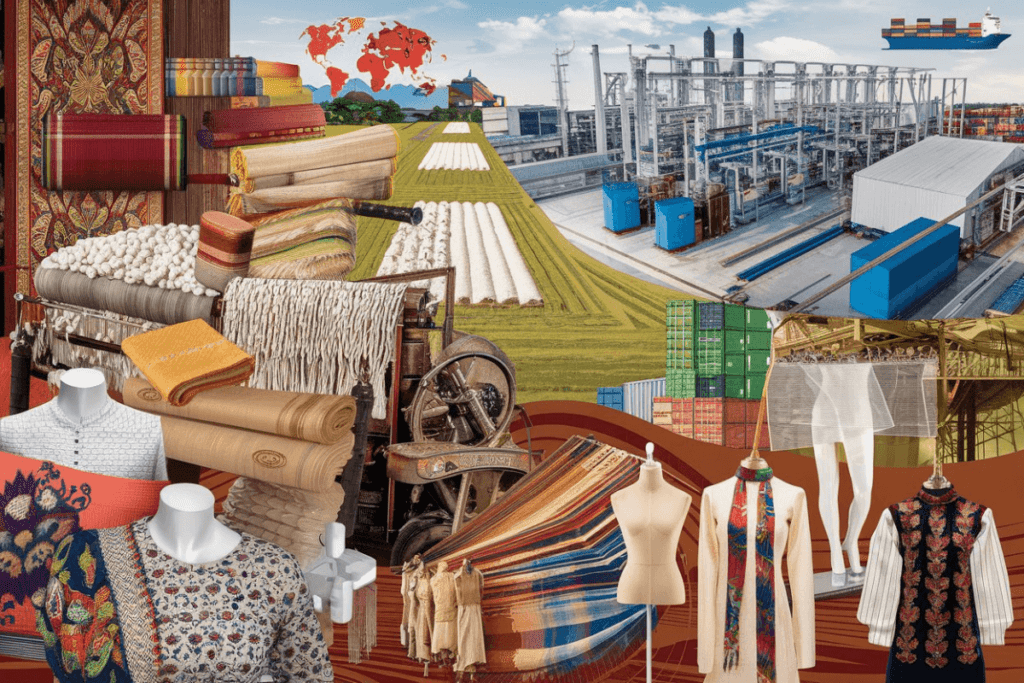
I. Economic Impact of the Textile Industry in India
The textile industry plays an important role in the textile industries of India; it contributes 2–3% of India’s GDP and 11–15% of earnings from exports. The employment creation function is also served since over 45 million people are directly employed, and about 60 million total employees are in related sectors.
The growth of the textile industry in India in the last 10 years is due to advancements in manufacturing, the government of India’s supportive approach through the Production-Linked Incentive (PLI) scheme, and consumer demand shifting toward eco-friendly and smart textile products. Such trends make it essential as one of the key pillar structures of the industrial framework of the country.
II. Major Sectors of the Textile Industry
The Indian textile industry is a complex sector that consists of several sectors that operate in relatively different roles towards the overall size and nature of growth.
1. Cotton Textiles:
The world’s largest producer of cotton is India, where they produce a lot of cotton, leading to the largest manufacturing units of it.
2. Handlooms and Handicrafts:
The internationally famous Indian textiles are very much of the type from this segment because of their exquisite design and standard ways of production.
3. Synthetic Textiles:
In the present world, wearing clothes made with synthetic fibres like polyester and nylon is quite common for clothing, and this is the reason it has also been taken up in India as well as in other parts of the world.
4. Technical Textiles:
For this purpose, medical textiles, industrial textiles, and protective clothing have emerged as new generations of textile products in India and can be defined as the future of this textile sector.
These sectors not only meet India’s domestic needs but also put India in a position to be a major exporter of textiles and garments.
III. Exports and Global Positioning
India has been at the top of the destinations for many years, with textiles to more than a hundred countries. Today, the Indian textile industry occupies 5% of the world textile and clothing market. It’s exporting everything, from high-end fabrics for apparel to low-end, ready-made garments.
The growth of the textile industry in India over the last 10 years is due to the improved dominance of globalisation and liberalisation. Concerning product quality, long-term supply, and, of course, affordable cost, India has become a preferred sourcing nation for international brands. Therefore, with the growth of technology in sustainable textiles and the innovation of smart textiles, the textile industry is definitely going to have a very bright future in India.
India’s exports have shown remarkable growth. To understand it deeply, check out our article on India’s textile exports: growth, impact, and global reach.
At textilerendshub.com, you’ll find a wealth of information on textiles, and we will strive to be your number one source. Discover traditional Indian textiles or the most recent breakthrough; here, we provide you with the information that you need to know. Tune in for more as we bring you more facts on the development of the textile industry in India.
Growth of the Textile Industry in India in the Last 10 Years
The growth of the textile industry in India in the last 10 years has made it one of the biggest progressive markets in the world. The development of innovations, sustainability, and global competitiveness has been taking place in this sector as one of the major parts of Indian culture and India’s economic structure. The next part of this article will include details about some particular milestones in the growth of the textile industry in India in the last 10 years and some innovations that have prepared the market for this evolution.
I. Milestones and Key Developments
The advancement of the growth of the textile industry in India in the last 10 years holds many significant events and achievements.
1. Rise in Exports:
The global market of garment fabrics and homewares has put India in the position of a leading exporter of textiles. For example, this sector, which mostly contributes about 8–11% of the country’s export earnings from textiles, is contributing almost 15% if sectors that fall under broader sectors, such as handicrafts, are taken into consideration.

2. Emergence of Technical Textiles:
Over the last decade, technical textiles have received a considerable amount of attention. Products manufactured by this industry are used in different segments, including the health sector as well as the automobile segment.

3. Focus on Sustainability:
The industry evolved in client consciousness about environmental hazards, and clients began to understand the use of environmentally sound materials, systems, and methods.

4. Increased Foreign Investments:
For instance, there are many policies of 100% foreign direct investment (FDI) in textiles; many investments arrived, thus manufacturing increased; therefore, they offered more jobs to people.

These are such signs of the future of the need and growth of the Indian textile industry, and a great combination of tradition and experience shall serve to sustain the need and growth of the textile industry in India.
II. Government Policies and Initiatives
The growth of the textile industry in India in the last 10 years is that it has blossomed thanks to a government that takes a keen interest in nurturing the right policies as well as looking for new ways.
1. Make in India Campaign:
This was launched in the year 2014, aimed at improving the manufacturing line sector, attracting overseas investors, and placing India on the textile map.

2. Production-Linked Incentive (PLI) Scheme:
The idea was to stimulate local production and also to make exports. This has facilitated the development of important segments such as man-made fibres and technical textiles.
To learn more about how the scheme works and who is benefiting, check out our detailed guide on the PLI Scheme for Textiles.

3. PM MITRA Scheme and Modern Textile Parks:
The government has introduced the PM MITRA Scheme to enhance the infrastructure of the textile industry with a goal to create seven world-class textile parks in India. These parks will integrate the entire textile value chain in one location, reducing costs and improving efficiency.

4. Skill Development Programmes:
In 2010, the government introduced the Integrated Skill Development Scheme (ISDS) to train workers in areas like handloom, apparel, and technical textiles. It was later replaced by Samarth (Scheme of Capacity Building in Textile Sector), which continues to offer industry-oriented, placement-linked training.
These programmes are helping build a skilled workforce and improving the presence of India in the global textile market.

The Indian textile industry is heavily supported by government initiatives. To explore detailed schemes, check out our guide on Government Schemes for the Textile Industry.
III. Technological Advancements and Innovations
Over the last decade, the textile industry in India has changed a lot in both technology and innovation.
1. Smart Fabrics:
Through technology applications in product development, wearable fabrics and temperature-control fabrics have been developed for the general society.

2. Automation and AI:
Due to the adoption of artificial intelligence (AI) in manufacturing, there has been a reduction in the cases of waste since production has been enhanced by this tool.

3. Sustainable Innovations:
In the Indian textile sector, absolute greening in each segment of textiles, starting from biodegradable fibres to waterless dyeing processes, has been put into practice.

4. E-commerce Integration:
At the same time, the emergence of outlets for such products on electronic selling platforms has benefitted Indian textiles in two ways: access to markets and increased sales and exposure.

The growth of the textile industry in India in the last 10 years is due to all such technologies, and it can compete with other industries in the global market.
To trace how the past decade set the stage for India’s textile future, read our comprehensive article on the growth of the textile industry in India in the last 10 years (2014–2024)—packed with trends, data, and forward-looking insights.
Indian Textiles: A Diverse and Vibrant Industry
The textile industry in India represents a significant aspect of Indian culture while at the same time coming up as one of the most promising industries in the modern world. Holding its own rich culture and tradition, the use of textile material in India has also always set a new standard in appreciation of craft and creation. It ranges from the finest conventional weaves to up-to-date hi-tech materials, making a beautiful picture of a combination of art and science.
I. Traditional Textiles: A Rich Heritage
Using fabrics, patterns, and techniques, the textile industry in India reflects a rich heritage in how those fabrics are made. For instance, there are regional differences in terms of fabrics. Many traditional techniques in the Indian textile industry hold a centuries-old status, including handloom weaving, block printing, and natural dyeing, to name a few.
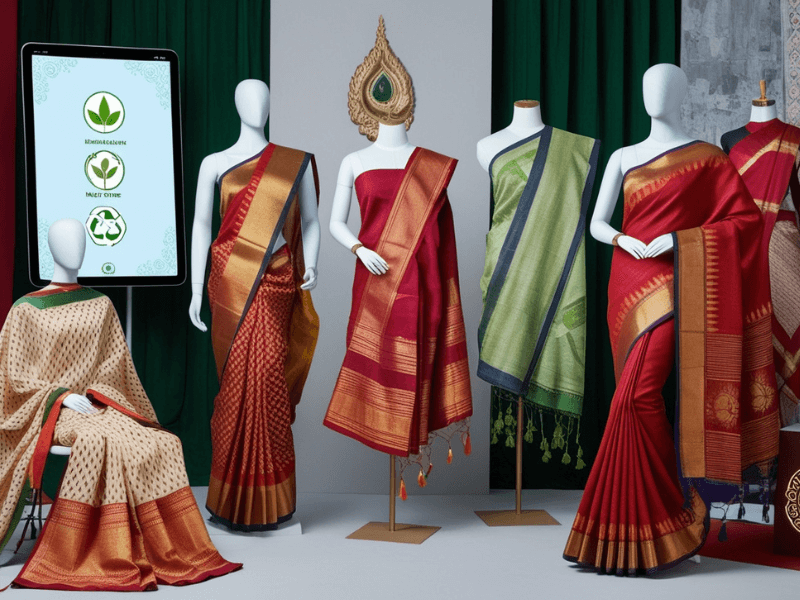
1. Banarasi Silk:
Traditional Indian fabrics cannot be complete without the Banarasi silk; it is famous for its sophisticated work and touch.
2. Pashmina Wool:
Starting from Kashmir, this sort of fine wool is accepted worldwide because of its naturally soft and warm nature.
3. Kanjeevaram Sarees:
Originally from Tamil Nadu, they are famous for their rich colour and golden zari work.
4. Bandhani:
Bandhani is a tie-dye textile that originated from Gujarat and Rajasthan and is characterised by a bright and dotted appearance.
These kinds of fabrics are not merely clothes; they are representations of the culture and arts of Indian civilisation.
II. Modern Indian Textiles: Adapting to Global Trends
However, the Indian textile industry, which was traditionally a handloom industry, has come out of the traditional methods to meet the modern universal demands. Today, with technology inputs and eco-friendly consciousness in view, Indian textiles have a gamut of products for modern needs.
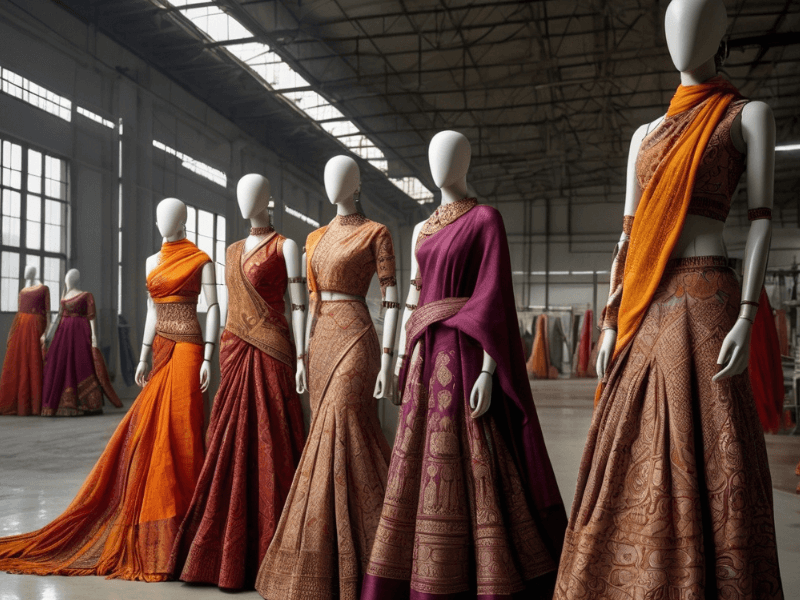
1. Technical Textiles:
These are designed for certain uses, such as medical use, automobile interiors, industrial uses, etc., thus proving India’s operational prowess.
2. Sustainable Fabrics:
Natural fibres, organic cotton, and recycled polyester products are slowly finding their way into the market due to global sustainability trends.
3. Smart Fabrics:
That’s why, along with futuristic smartphones, the Indians have introduced garments that can cool or warn about overheating, act as health indicators, or protect the skin from ultraviolet radiation.
Such flexibility has proved advantageous within the textile industry in India for constant business within the unstable global market.
III. Export Demand and Regional Specialisations
The existing demand for Indian textiles in the global market remains high due to innovation in designs and professionalism in finishing. Each region of India contributes to this global appeal with its specialised offerings:
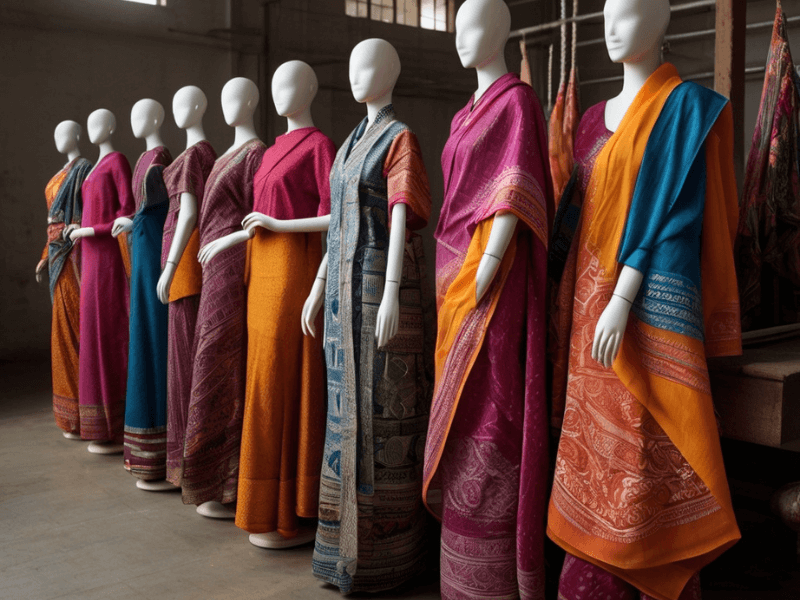
1. Gujarat and Rajasthan:
These regions, famous for Bandhani and block-printed fabrics, are exporters of striking and handmade fabrics.
2. Tamil Nadu:
A hub for cotton and silk production, Tamil Nadu has industries that can supply both the traditional and fashion-oriented markets.
3. Punjab:
Though Punjab primarily occupies a minor segment in the fashion and home furnishing accessories market, it is famous worldwide for its sturdy and colourful Phulkari embroidery work.
4. Northeast India:
Through hand-woven fabrics such as Muga silk or Eri silk, the northeastern states are stepping up for eco-friendly fabric production.
India’s regional specialisations not only enhance the export base argument of the textile industry in India but also explain its various diversifications.
Future of the Textile Industry in India
The textile industry in India has always been vibrant, even though it may be relatively young compared to many other industries in other countries. Looking ahead, the future of the textile industry in India appears even more promising, driven by technological evolution, sustainability priorities, and smart textile innovations. The transformations expected in the next decade are set to significantly advance the industry, positioning India as a global leader in the textile sector.
I. Emerging Trends: Smart Fabrics and Sustainability
Another issue that is expected to be in the future of the textile industry in India is sustainability and smart fabrics. The world is continuously moving toward the adoption of green products, and thus, the adoption of eco-friendly textiles is expected to rise as well. India, because of its enormous source of natural fibres and diverse traditional textile culture, could well suit this purpose.
1. Sustainable Materials:
This means that the shift from using conventional sources such as cotton to organic and hemp products and recycled fibre will go on steadily. These fibres demand less resource input, are friendlier to the environment, and are now rapidly and popularly used in the environmentally sensitive market.
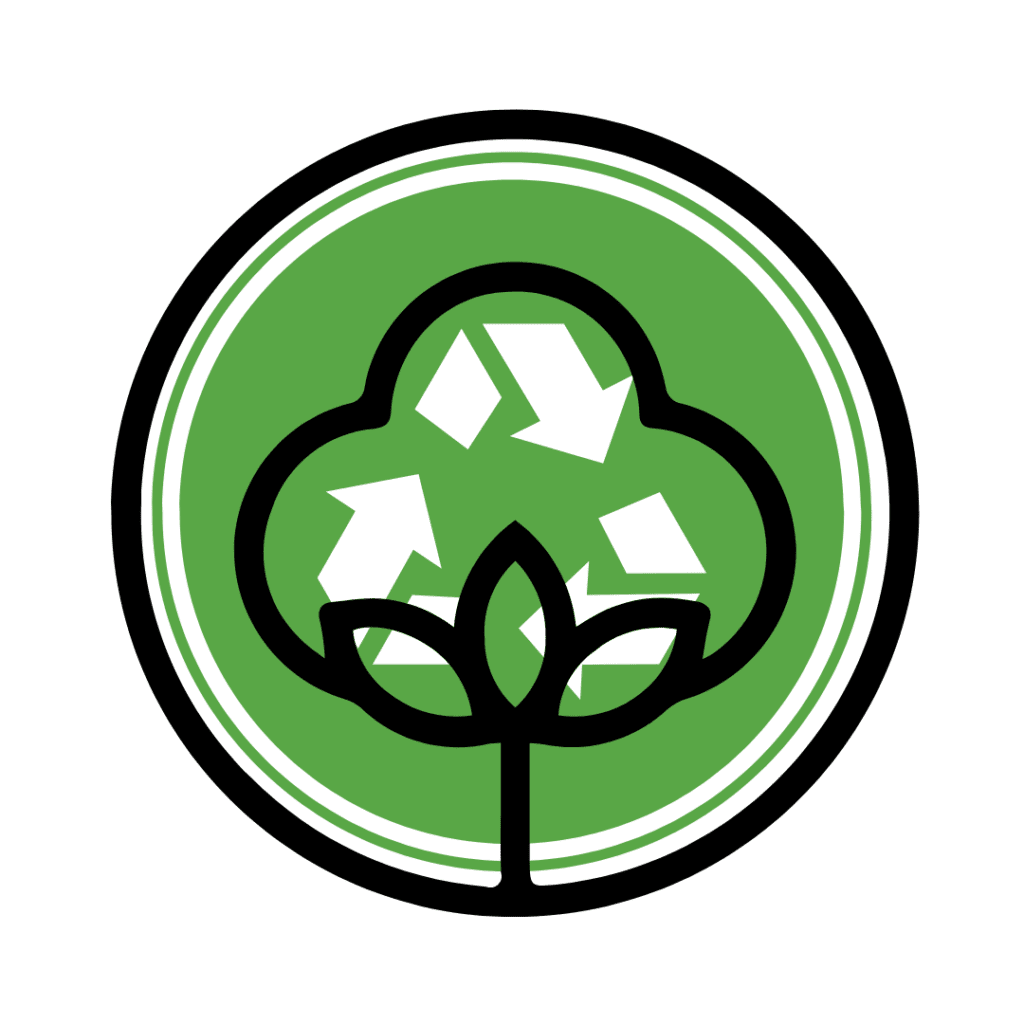
2. Waterless Dyeing and Chemical-Free Processing:
The extent of integrated technologies like waterless dyeing and newer eco-friendly processes of finishing will be further. These processes decrease the extent of the effect on the environment with reference to textile production and uphold the sustainable development aspirations of India.

3. Smart Fabrics:
The ability of textiles to undertake activities beyond usage is another major area of concern in the research. Advanced garments, or wearable technology textiles, are expected to rise in India. Such fabrics can be used to monitor health, regulate body temperature, or store electricity for other devices. This new category of textiles has the ability to revolutionise almost every industry, ranging from the health field or sports to fashion.

It is telegraphed that the textile industry in India is all set to reap the benefits of these innovations and bring in a more sustainable and technologically advanced change.
II. Technological Disruptions and Innovations
This is especially due to advanced technologies that are now shaping the manner in which textiles are developed, manufactured, and used. The assessment also reveals that the future of the textile industry in India will undergo some changes across manufacturing and designing and even in the usage of artificial intelligence and 3D printing.
1. Automation in Manufacturing:
Credit for the shift is due to the gradual move of operations from mostly manual to mainly operated by machines. This has a direct impact on cost reduction, reduction in cycle time, and improvement in product quality. Automation will also fill the labour gaps that have long threatened the textiles industry.

2. Artificial Intelligence and Data Analytics:
The utilisation of AI will be a significant focus of advancement applied to designs, the planning of production and scheduling, and the ability to predict trends. It will give adequate support to the manufacturers to make a proper evaluation of their performance, improve the product, and meet customers’ needs.

3. 3D Printing:
Custom-made fabrics and garments through the use of 3D printing will be another feature that will dominate the fashion industry. In particular, using this technology, it is possible to build complex designs and structures that would be impossible to implement with other technologies.

These technological disruptions will ensure efficiency in operations and make additional prospects for creativity in the textile industry in India possible.
III. Global Market Outlook and India’s Position
The textile market around the globe is estimated to continue to be on the rise in demand for eco-friendly as well as high-tech fabrics. The future of the textile industry in India looks promising, as the country is set to solidify its position as the world’s largest textile manufacturing country in the coming decade, particularly through exploiting developments that are being witnessed.
1. Growing Demand for Sustainable Textiles:
In light of rising awareness regarding climate problems, the use of eco-friendly fabrics will grow steadily. India produces natural fibre in large quantities in the world, and now the world has demanded eco-sustainable fabrics, and the country has all the potential to cater to the supplies in this segment.

2. Shift in Global Supply Chains:
The textile industry in India will derive benefits from a change in global sourcing patterns as many companies turn toward India due to an attempt to diversify from China. Pricing pressure on Indian suppliers will decline rapidly, while the availability of skilled labour and government support will help the country become an attractive route for different brands with their supplies.

3. Digitalisation of the Market:
Electronic media and digitally extended markets are setting more pace in the textile export chain. The Indian textile manufacturers will keep on experimenting with digital platforms to reach out to their international customers, cut out middlemen, and simplify exports.

The future of the textile industry in India depends on its capacity to build a response to these trends. India’s position as the leader in textiles will be further cemented with an emphasis on sustainability, technology, and quality.
IV. Predictions and Challenges for the Next Decade
On the bright side, the future of the textile industry in India appears bright, but there are problems that need to be solved.
1. Supply Chain Disruptions:
The organisation of the global textile supply chain has undergone a number of shifts over the recent past, mainly because of the COVID-19 outbreak and tensions in the geopolitical environment. The country will also have to reinforce vulnerabilities in the chain in order to sustain its worldwide standing.

2. Skilled Labour Shortage:
Despite this large labour force, the textile industry still has an insufficient quantity of skilled labour. Training institutions need to be developed to produce a qualified workforce for the introduction of new systems and ideas in the production of textiles.

3. Environmental Impact:
Textiletrendshub.com also noted that although much effort is being made for sustainable manufacturing, the textile industry is still one of the biggest polluters. The Indian textile industry will be required to adapt to greener ways of carrying out its business to harmonise with the current global environmentalism call and respond to the call for sustainable production.

However, the factors above threaten the growth of the textiles industry in India, which can, however, continue to grow in the future years. Incorporating innovations, sustainability, and technologies in the textile industry in India, India is again poised to hold dominance in the textile market.
For more insights on how the future of the textile industry in India is being reshaped by sustainability and innovation, see our article “Future of the Textile Industry in India: How Sustainability and Innovation Are Shaping Tomorrow.”
Challenges and Opportunities in the Indian Textile Industry
The textile industry in India is one of the largest as well as most complex; however, it has issues with its progression. However, there are numerous opportunities for business development, for instance, opportunities that are as yet unexplored, like the sustainability field or advancements in technology. The future of the Indian textile industry appears promising, provided it can overcome the challenges highlighted below; the country can become a world leader in eco-friendly textiles and value-added textiles.
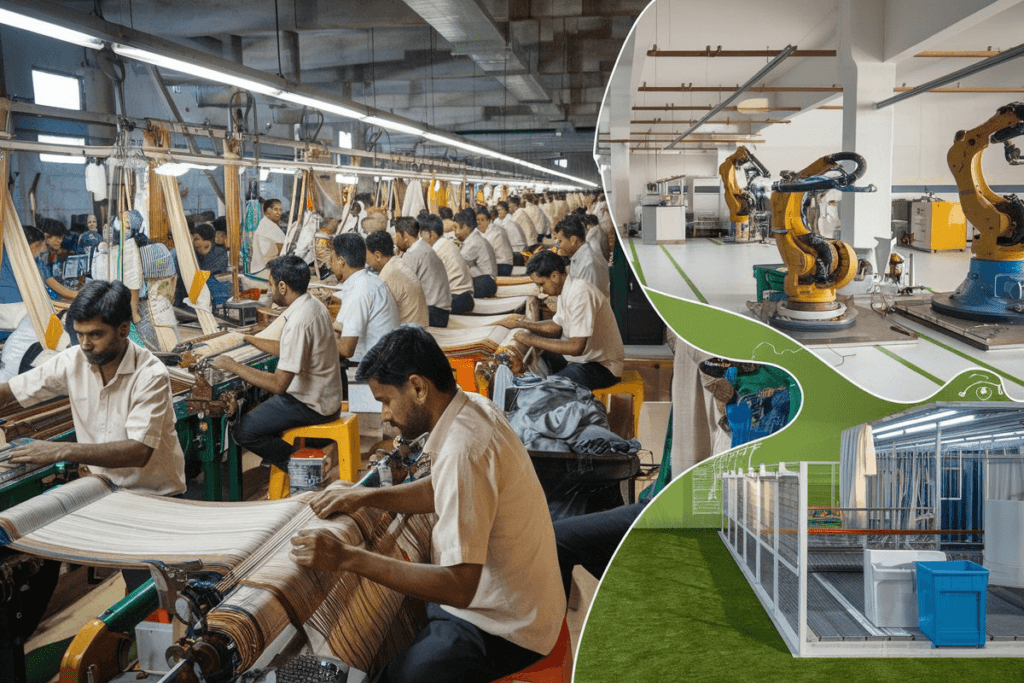
I. Labour Challenges and Workforce Development
In terms of the structure of the labour force in the textile industry in India, one can pinpoint one of the major problems. The manufacturing industry needs manpower, and in the handloom & garments sectors, manpower is more used depending on the industry. However, there is a lack of skilled labourers; there are such issues as low wages, no staff training, and health-compromising working conditions. This has resulted in social unrest and poor working morale in some areas across the country.
To counter these challenges, the Indian textile industry is required to train its workforce; proper skill training programmes should be developed, and working conditions should be upgraded to attract talented personnel. With the demand for automation growing in organisations, the workforce is urged to jump on technology and train new skills in order to stay competitive in the global market.
II. Environmental and Sustainability Concerns
The biggest challenge that the textile industry in India has is environmental issues. The textile manufacturing industry, especially dyeing and finishing processes, uses water immensely and generates waste. Not only does the fabric and apparel industry rely on synthetic fibres and chemically intensive processes, but it also contributes to the problem.
Thus, sustainability is a challenge; however, it also comes with opportunity. As many more consumers begin to notice what they are putting their money into and the effects these have on the environment, there is a need for more sustainability in textiles.
If the question is to determine which of the sectors competing for the top spot has been the first to adopt sustainability measures such as waterless dyeing or biodegradable fibres and garment recycling, among others, if the emphasis is placed more on what is causing change rather than the outcomes of the so-called “green” manufacturing processes, not only will its impacts be addressed but also a market that is quickly expanding globally for sustainable textiles will be created.
III. Opportunities in Global Markets and Emerging Trends
The textile industry in India is very competitive; it competes against China and Bangladesh, but it also offers great scope for growth across global markets. The demand for eco-friendly textiles is just one of the most promising opportunities. With people around the world becoming increasingly conscious of the environment, they are turning to sustainable fabrics, organic cotton, and recycled materials. India’s existing expertise in producing cotton, combined with its emerging priority on sustainable textiles, placed India in a good position to supply this global demand.
Beyond this, the Indian textile industry can also have tremendous potential and scope for technology upgrades. Advanced textiles, mechanisation, and digitalisation of the textile business transform the textile sector. Since India is at the stage of building artificial intelligence (AI), automation, and 3D printing technologies, it is possible for the country to lead in the textile industrial solution using creative innovations. But with the right capital outlay, these opportunities will translate into making India a leading producer of advanced application textiles used in health care, sports, and fashion.
Role of Sustainability in Indian Textiles
The textile industry in India is focusing on sustainability as both consumers and businesses are concerned about the need for eco-responsibility in the overall textile business. The shift to greening textile manufacturing has come on the back of its harmful effect on the environment, with a lot of water consumption and utilisation of nonrenewable resources. In this application, the innovation of textiles that are able to remove the environmental burden while ensuring the quality and allure of the products is being adopted by Indian textiles.
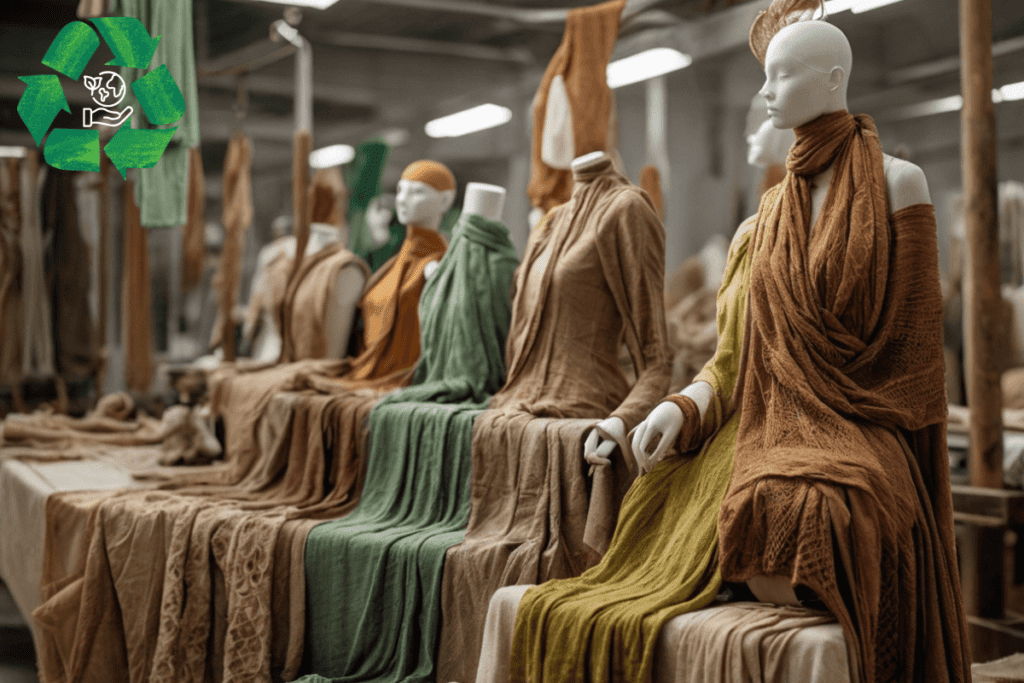
I. Sustainable Fabric Innovations in India
The development of sustainable fabrics is one of the driving forces in sustainability in the textile industry in India. Today, manufacturers are tending more and more to finding organic cotton, hemp, jute, or bamboo fibres that have a much smaller environmental footprint than traditional cotton and synthetic materials. That means those fabrics require less water and fewer chemicals, making the process of production more environmentally friendly. Similarly, Indian textiles are innovative in green dyeing and finishing technology, which is less energy- and water-intensive, using natural dyes, plants, and mineral bases.
II. Government Policies Promoting Sustainability
The role that has evolved for India is to recognise the importance of sustainability in the context of the textile sector in India and put in place a framework for fashioning a sustainable textile future. Eco-friendly, renewable reforestation, and general conservation of natural resources are equally looked into when it comes to programmes like the Textile Mission and the National Textile Policy. Second, other programmes like Make in India also allow the manufacture of eco-friendly fabrics in the locality. On this note, these policies have helped to introduce sustainability to a larger extent in Indian textiles.
III. Challenges and Achievements in Sustainable Practices
The shift in direction towards sustainability in Indian textiles is positive, as is; however, it’s not been an easy ride. However, many manufacturers find it difficult to balance sustainability with lower-cost production. The industry has deep roots in traditional processes, and transitioning to greener alternatives can be expensive and demand investment. But a host of steps have been taken, including the rise of eco-friendly brands and more sustainable materials becoming available in India. With the growing need for sustainable textiles from both domestic and foreign markets, the industry is moving toward a more sustainable future.
To get more information on the seed we are sowing for a sustainable textile industry in India, check out our article “Sustainability of Fabrics: Eco-Friendly Future of the Textile Industry.“
Conclusion and Next Steps
The textile industry in India is an important pillar of the country’s economy, serving as an employment multiplier, an export multiplier, and a trade multiplier on a global basis. The Indian textile industry has witnessed great strides in the past few years and is currently ranked as one of the biggest industries in the world that combines traditional heritage with contemporary theories. The growth of the textile industry in India in the last 10 years has been huge, mainly due to technological advancements, the emergence of sustainability practices, and an upswing on the global textile stage for Indian textiles. It’s setting the table for even more success later on.
In the future, the textile industry in India will show promise of exciting innovation, combined with an increase in focus on sustainability. The responsible path for the industry will be to abide by eco-friendly practices and smart fabrics and be the best in the global market of sustainable textiles. But the road is not going to be easy either; there will be challenges of labour concerns, environmental issues, and growing competition from other countries on that. To be competitive, the Indian textile industry needs to work at increasing workforce development, curtailing pollution, and utilising technology to improve productivity and efficiency.
If you want to stay updated with the latest developments and trends in the textile industry in India and are looking for comprehensive insights into this industry, you would love to visit textiletrendshub.com, where you can stay updated with all the latest developments and trends in the Indian textile industry.

Q1. Why is India considered a global leader in the textile and fashion industry?
India’s textile and fashion industry stands out globally due to its rich heritage of traditional crafts like Khadi and Banarasi, combined with modern advancements in sustainable practices and technology. The sector contributes approximately 2.3% to India’s GDP and employs over 45 million people, highlighting its significant role in the global market.
Q2. What are the main factors driving changes in the Indian textile and fashion industries?
Key drivers include India’s cultural diversity influencing design, technological innovations like AI and AR enhancing production and retail, sustainability initiatives promoting eco-friendly materials, and evolving consumer preferences favouring ethical and personalised fashion choices.
Q3. How does sustainability impact the Indian fashion industry?
Sustainability has become central to India’s fashion industry, with a focus on eco-friendly materials, garment recycling, and ethical production practices. Consumers increasingly prioritise environmentally responsible clothing, driving brands to adopt sustainable methods.
Q4. What is fusion wear, and why is it popular in India?
Fusion wear combines traditional Indian attire with Western styles, offering versatility for various occasions. Its popularity stems from preserving cultural heritage while embracing modern fashion trends.
Q5. What are the key textile innovations transforming the industry?
Innovations such as smart fabrics that adjust to temperature, sustainable materials like organic cotton and bamboo fibres, and waterless dyeing techniques are revolutionising India’s textile industry, making it more efficient and eco-friendly.
Q6. How is technology influencing Indian fashion trends?
Technologies like Artificial Intelligence (AI) and Augmented Reality (AR) are reshaping Indian fashion by enabling virtual try-ons, personalised recommendations, and streamlined production processes, enhancing the shopping experience and operational efficiency.
Q7. How are traditional Indian textiles like Khadi and Banarasi being revived in modern fashion?
Traditional Indian textiles such as Khadi and Banarasi are being revitalised through a blend of government support and modern design. Initiatives like the Khadi and Village Industries Commission (KVIC) promote local artisans, while collaborations with contemporary designers have reintroduced these fabrics in everyday wear, office attire, and festive collections. This revival bridges heritage with trend, making timeless crafts relevant to new generations.
Q8. What is the role of influencers in shaping Indian fashion trends?
Influencers on platforms like Instagram and YouTube play a pivotal role in shaping Indian fashion trends by endorsing local artisans and sustainable brands, thereby influencing consumer preferences towards eco-conscious and culturally rich fashion.
Q9. What are the prospects for India’s textile exports?
India’s textile exports, valued at approximately $44.4 billion in FY22, are poised for growth through initiatives like the Production Linked Incentive (PLI) scheme and the establishment of Mega Textile Parks, enhancing global competitiveness.
Q10. How is circular fashion shaping the future of Indian textiles?
Circular fashion, emphasising recycling and reusing materials, is gaining traction in India. Brands are adopting practices like upcycling and garment recycling to minimise waste and promote sustainability.
Q11. What role does AI play in Indian textile manufacturing?
Artificial Intelligence (AI) in Indian textile manufacturing aids in demand forecasting, quality control, and personalised design recommendations, leading to increased efficiency and customer satisfaction.
Q12. How is the Indian government supporting the textile industry?
The Indian government supports the textile industry through the Production Linked Incentive (PLI) scheme, offering incentives for manufacturing excellence and the development of mega textile parks to provide integrated infrastructure, boosting employment and global competitiveness.
Q13. What are eco-friendly fabrics, and why are they important?
Eco-friendly fabrics like organic cotton and hemp are sustainably produced, reducing environmental impact. They offer consumers healthier, biodegradable options, contributing to a lower carbon footprint in fashion.
Q14. What is textile recycling, and how is it practised in India?
Textile recycling in India involves processes like upcycling and fabric repurposing, where old garments are transformed into new products. Designers and manufacturers are increasingly adopting these methods to promote sustainability.
Q15. Are Indian consumers adopting sustainable fashion?
Yes, Indian consumers are increasingly adopting sustainable fashion. Many are choosing eco-friendly and ethical clothing options over fast fashion.
Q16. How does the Indian textile industry contribute to employment?
The Indian textile industry is one of the largest employment generators in the country, second only to agriculture. It provides direct employment to over 45 million people and indirectly supports another 100 million through allied sectors. This includes workers in spinning, weaving, dyeing, and garment manufacturing, as well as artisans and rural craftspeople.
Q17. What role do MSMEs play in the textile sector?
Micro, Small, and Medium Enterprises (MSMEs) are the backbone of the Indian textile sector. They contribute significantly to domestic production and exports by supporting regional weavers, small-scale manufacturers, and handloom clusters. The government supports these units through schemes aimed at technology upgradation and financial access.
Q18. How is India positioning itself globally in textile exports?
India is strengthening its global position by focusing on high-quality production, sustainable practices, and integrated textile parks. Key export destinations include the US, the EU, and Middle Eastern countries. Initiatives like the PLI scheme and free trade agreements are further enhancing India’s competitiveness on the global stage.
Q19. What are the post-pandemic challenges and opportunities for the textile industry?
Post-COVID, the Indian textile industry faced disruptions in supply chains and reduced export demand. However, the pandemic also accelerated digitisation and the adoption of sustainable practices. With rising global interest in ethical sourcing and local manufacturing, India now has an opportunity to emerge as a more resilient textile hub.
Q20. Who can benefit from reading Textile Trends Hub?
Designers, manufacturers, business professionals, students, and fashion enthusiasts looking to stay updated with industry trends can benefit from the content.





[…] For more information regarding the trends that are bound to shape the future of the Indian fashion industry, read Game-Changing Trends in the Indian Fashion and Textile Industries for 2025 and Beyond. Also, if you require a detailed analysis of the economic impact and growth milestones of the textile industry, you can read our article “Unveiling the Textile Industry in India: Economic Impact, Growth Milestones, and Prospects.“ […]
[…] Explore trends that are transforming the clothing market of India in our article “Explore Current Fashion Trends in India: A Journey into Style and Innovation.” Also, if you require a detailed analysis of the economic impact and growth milestones of the textile industry, you can read our article “Unveiling the Textile Industry in India: Economic Impact, Growth Milestones, and Prospects.“ […]